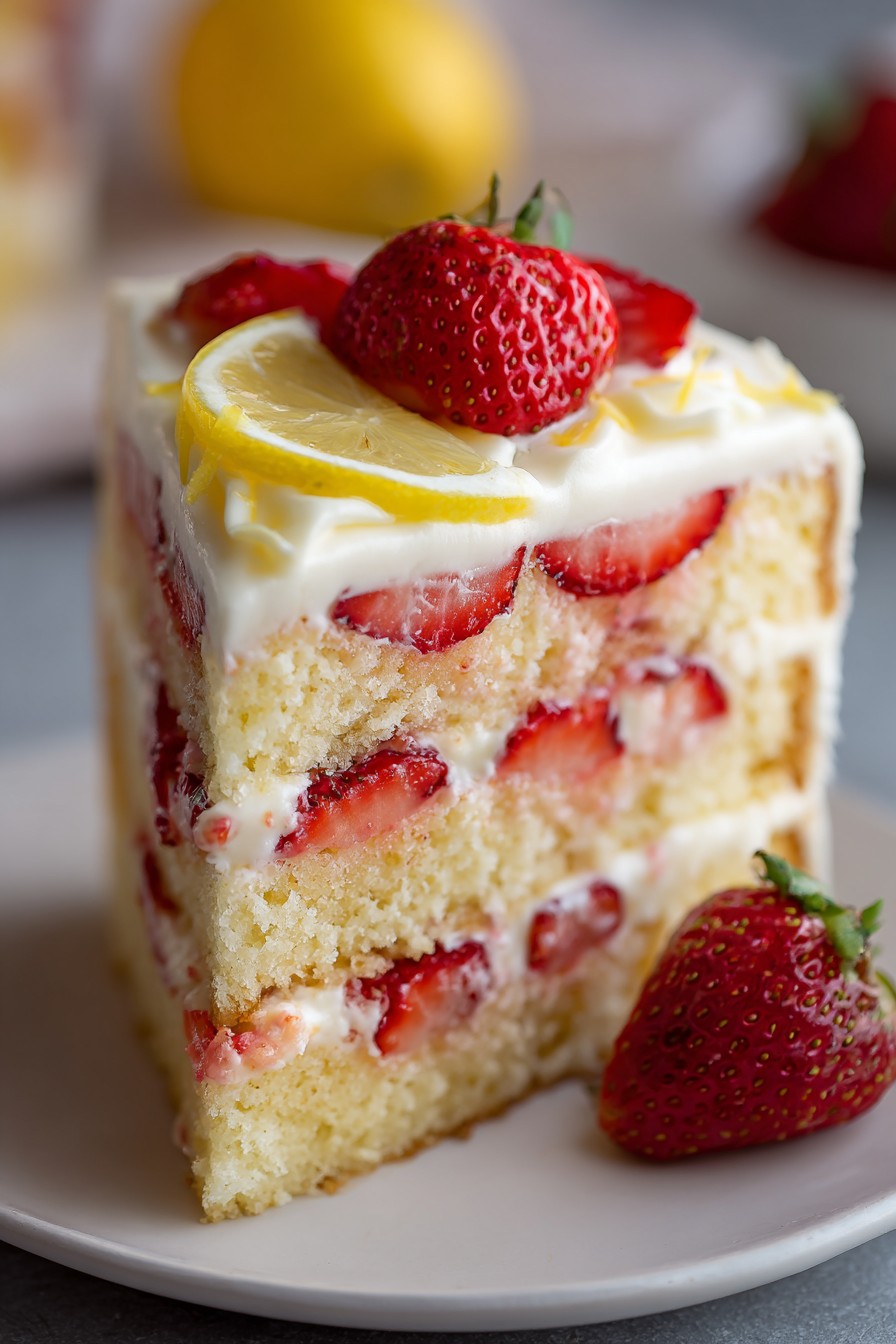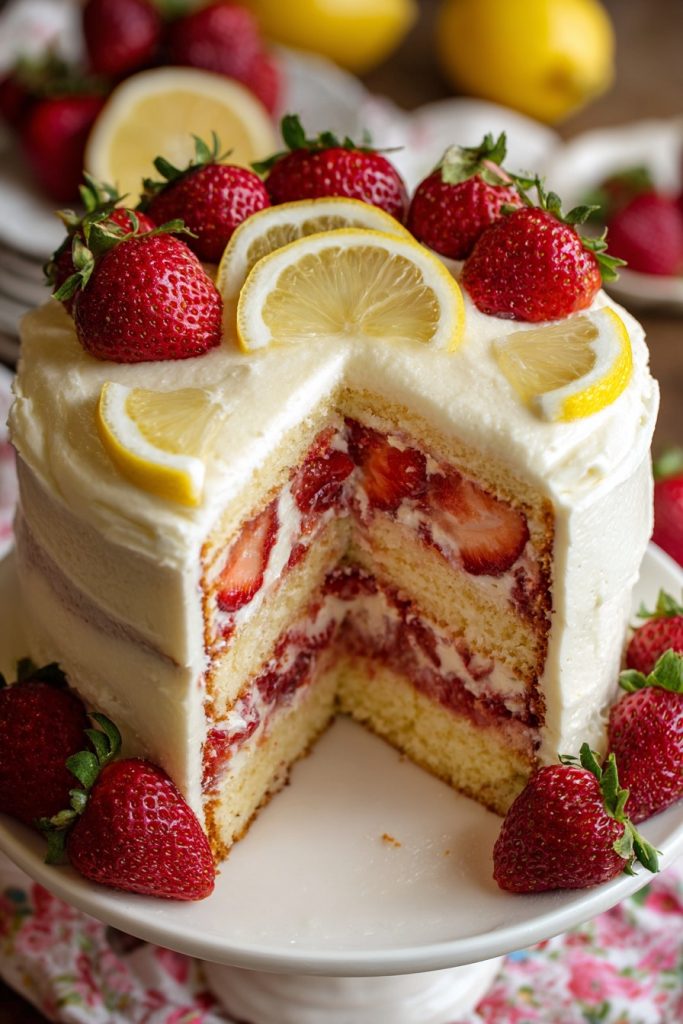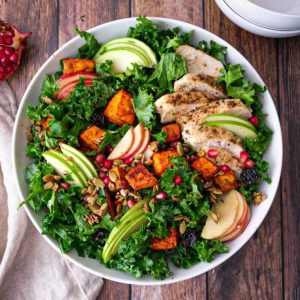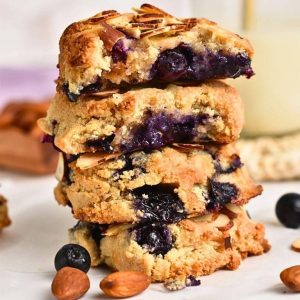Visions of sun-drenched berry patches and lazy afternoons on the porch come flooding back whenever I bake this strawberry lemonade cake. This recipe has been in my family for three generations, originally scribbled on a faded index card by my grandmother who believed that the best desserts should taste like bottled sunshine. Every bite transports me back to those carefree summer days when life moved at the pace of honey dripping from a spoon.
Why This Recipe Works
- The combination of fresh strawberry puree and real lemon zest creates an authentic lemonade flavor that sings with bright, tangy sweetness, perfectly capturing that nostalgic taste of homemade lemonade stands and berry-picking adventures.
- Using buttermilk in the batter ensures an incredibly moist, tender crumb that stays fresh for days, while the acidic tang beautifully complements the fruity notes without overwhelming the delicate balance of flavors.
- Layering the cake with fresh strawberry slices between each tier adds bursts of juicy texture and intensifies the berry flavor, creating delightful surprises in every forkful that make this dessert truly special.
- The cream cheese frosting, lightly sweetened and whipped to cloud-like perfection, provides the perfect creamy counterpoint to the bright, zesty cake while allowing the strawberry and lemon flavors to remain the stars of the show.
- Baking the cake at precisely 350°F for 30-35 minutes creates that perfect golden-brown crust while maintaining a moist interior, giving you that professional bakery-quality result right from your own kitchen.
Ingredients
- 2 ½ cups all-purpose flour, sifted to remove any lumps
- 1 ½ cups granulated sugar
- ¾ cup unsalted butter, softened at room temperature
- 3 large eggs, brought to room temperature
- 1 cup fresh strawberry puree (from about 2 cups whole strawberries)
- ½ cup buttermilk
- 2 tablespoons fresh lemon zest (from about 3 medium lemons)
- ¼ cup fresh lemon juice
- 2 teaspoons baking powder
- ½ teaspoon baking soda
- ½ teaspoon salt
- 1 teaspoon vanilla extract
- 1 cup fresh strawberries, hulled and thinly sliced for layering
- 8 ounces cream cheese, softened
- ½ cup unsalted butter, softened
- 3 cups powdered sugar
- 1 teaspoon vanilla extract
- Pinch of salt
- Fresh strawberry halves and lemon slices for garnish
Equipment Needed
- Two 9-inch round cake pans
- Stand mixer or electric hand mixer
- Mixing bowls in various sizes
- Rubber spatula
- Wire cooling rack
- Parchment paper
- Measuring cups and spoons
- Fine mesh sieve
- Zester or microplane
- Juicer or citrus reamer
- Blender or food processor
- Offset spatula for frosting
- Cake tester or toothpick
Instructions

Preparing the Strawberry Puree and Dry Ingredients
Begin by washing and hulling two cups of fresh strawberries, then pat them dry thoroughly to prevent excess moisture in your puree. Place the berries in your blender or food processor and pulse until you achieve a smooth, vibrant red puree—this should take about 30-45 seconds depending on your appliance. Measure out exactly one cup of this fresh strawberry puree and set it aside, saving any extra for another use. Meanwhile, in a medium mixing bowl, whisk together two and a half cups of sifted all-purpose flour with two teaspoons of baking powder, half teaspoon each of baking soda and salt. Sifting the flour first ensures your cake will have that light, airy texture reminiscent of old-fashioned farmhouse baking, while properly measuring your leavening agents guarantees the perfect rise. Tip: For the most intense strawberry flavor, use berries that are fully ripe and fragrant—they should give slightly when gently pressed and fill your kitchen with their sweet aroma.
Creaming the Butter and Sugar with Wet Ingredients
In the bowl of your stand mixer fitted with the paddle attachment, combine three-quarters cup of softened unsalted butter with one and a half cups of granulated sugar. Beat these together on medium-high speed for a full three to four minutes until the mixture becomes pale, fluffy, and almost whipped in texture—this crucial step incorporates air that will help your cake rise beautifully. Scrape down the sides of the bowl with a rubber spatula, then add three room-temperature eggs one at a time, beating well after each addition until fully incorporated. Now slowly pour in your prepared strawberry puree, half cup of buttermilk, quarter cup of fresh lemon juice, and one teaspoon of vanilla extract, mixing on low speed just until combined. The buttermilk adds wonderful tanginess while keeping the crumb exceptionally moist, creating that melt-in-your-mouth quality that makes this cake so memorable.
Combining the Batter and Adding Citrus Zest
With your mixer on the lowest speed, gradually add the pre-whisked dry ingredients to the wet mixture in three separate additions, mixing just until the flour disappears and no white streaks remain—be careful not to overmix at this stage. Using a rubber spatula, gently fold in two tablespoons of freshly grated lemon zest, making sure to distribute those bright citrus notes evenly throughout the batter. The zest should come from organic or thoroughly washed lemons since you’re using the outer peel, and grating it directly over the bowl captures all those precious essential oils. The batter will be thick but pourable, with a beautiful pale pink hue from the strawberry puree and speckled with those vibrant yellow lemon zest bits that promise bursts of sunshine in every bite.
Baking and Testing for Doneness
Preheat your oven to 350°F and generously grease two nine-inch round cake pans, then line the bottoms with parchment paper circles to ensure easy release. Divide the batter equally between the prepared pans, using a kitchen scale for precision or eyeballing it carefully, then smooth the tops with your spatula. Bake in the center of your preheated oven for 30-35 minutes, rotating the pans halfway through to ensure even browning. The cakes are done when they spring back lightly when touched in the center, the edges pull slightly away from the pans, and a toothpick inserted into the middle comes out clean with just a few moist crumbs attached. Tip: For the most level cake layers that won’t require trimming, try using cake strips around your pans—these simple fabric strips soaked in water help the cakes bake evenly from edge to center.
Cooling and Preparing the Frosting
Remove the cakes from the oven and let them cool in their pans on a wire rack for exactly fifteen minutes—this allows them to set properly without becoming soggy. Then carefully run a knife around the edges and invert them onto the cooling rack, peeling off the parchment paper and allowing them to cool completely, which typically takes about two hours. While the cakes cool, prepare the cream cheese frosting by beating eight ounces of softened cream cheese with half cup of softened butter until perfectly smooth and fluffy, about two minutes on medium speed. Gradually add three cups of sifted powdered sugar, one teaspoon of vanilla extract, and a pinch of salt, beating until the frosting is light, spreadable, and holds soft peaks. Tip: For the smoothest frosting free of lumps, make sure both your cream cheese and butter are truly at room temperature—they should yield gently when pressed with your finger.
Assembling and Frosting the Finished Cake
Place one completely cooled cake layer on your serving plate or cake stand and spread about three-quarters cup of frosting evenly over the top using an offset spatula. Arrange one cup of thinly sliced fresh strawberries in a single layer over the frosting, pressing them gently into the creamy surface to create those lovely berry pockets. Carefully place the second cake layer on top, making sure it’s centered and level, then apply a thin crumb coat of frosting over the entire cake and refrigerate for twenty minutes to set. Finally, frost the chilled cake with the remaining frosting, using your spatula to create beautiful rustic swirls that look homemade rather than perfectly smooth—this charming imperfection is part of the farmhouse appeal. Garnish the top with fresh strawberry halves and thin lemon slices arranged in a casual, artful pattern that hints at the delightful flavors waiting inside.
Tips and Tricks
For those looking to elevate this already wonderful cake to absolute perfection, here are some grandmother-approved tips gathered through decades of baking. When selecting strawberries, choose berries that are deep red throughout rather than just at the tips—these will provide the most intense flavor and vibrant color to your puree. If your strawberries aren’t quite as sweet as you’d like, you can macerate them before pureeing by tossing with a tablespoon of sugar and letting them sit for thirty minutes, which draws out their natural juices and enhances their sweetness. For the lemon zest, always zest your lemons before juicing them—it’s nearly impossible to do it the other way around—and avoid the white pith beneath the yellow zest as it can impart bitterness. When measuring flour, use the spoon-and-level method rather than scooping directly from the bag with your measuring cup, which can pack in too much flour and result in a dense cake. Room temperature ingredients are non-negotiable for proper emulsion—if you forgot to take your eggs and dairy out ahead of time, place cold eggs in warm water for ten minutes and microwave butter in five-second bursts until softened but not melted. For the cleanest cake layers when slicing, use dental floss or a long serrated knife and wipe it clean between cuts. If your kitchen is particularly warm and the frosting becomes too soft while you’re working with it, simply pop the bowl into the refrigerator for fifteen minutes to firm up. For make-ahead convenience, you can bake the cake layers up to two days in advance, wrap them tightly in plastic wrap, and store at room temperature, or freeze them for up to three months. When transporting your finished cake, place it in the refrigerator for at least thirty minutes first to set the frosting, then keep it out of direct sunlight during travel. For the most beautiful presentation, consider toasting some shredded coconut and pressing it onto the sides of the frosted cake for added texture and visual appeal that will have your guests marveling at your baking prowess.
Recipe Variations
- For a delightful summer picnic version, bake the batter in a 9×13-inch pan and skip the layering—simply frost the single sheet cake and scatter fresh berries over the top for easy serving outdoors. This casual approach still delivers all the wonderful flavors but with far less fuss, making it perfect for potlucks, family reunions, or those lazy Sunday afternoons when you want something special without the ceremony.
- Transform this into stunning cupcakes by dividing the batter among 24 lined muffin cups and baking at 350°F for 18-22 minutes until a toothpick comes out clean. Once cooled, pipe the cream cheese frosting using a star tip and garnish each with a fresh strawberry slice—these individual portions are ideal for school parties, bake sales, or when you want to share sunshine with neighbors and friends.
- Create an elegant layered trifle by baking the cake in a 9×13 pan, then cutting it into cubes and alternating layers with the cream cheese frosting (thinned with a tablespoon of milk), fresh strawberry slices, and even some lemon curd if you’re feeling adventurous. Served in a beautiful glass bowl, this deconstructed version showcases all the components while making preparation and serving wonderfully simple for large gatherings.
- For a decadent twist that chocolate lovers will adore, add half cup of white chocolate chips to the batter and substitute lemon extract for the vanilla in the frosting. The creamy white chocolate provides lovely little pockets of sweetness that complement the bright berry and citrus notes, creating a more sophisticated dessert perfect for dinner parties or special occasions that call for something extra memorable.
- Embrace the seasons by substituting other fruits—try raspberry lemonade in summer, blackberry limeade as autumn approaches, or cranberry orange during the holiday months. Each variation maintains the same basic method while allowing you to work with what’s fresh and local, continuing that farmhouse tradition of baking with the bounty that nature provides throughout the year.
Frequently Asked Questions
Can I use frozen strawberries instead of fresh?
Absolutely, frozen strawberries work wonderfully in this recipe, though there are a few adjustments to ensure success. Thaw the berries completely in a strainer set over a bowl to catch the excess liquid, then use them exactly as you would fresh berries for the puree. You may need to reduce the buttermilk by about two tablespoons since frozen berries release more moisture during thawing, and your puree might be slightly less vibrant in color but will still deliver fantastic flavor. This substitution makes the cake accessible year-round, allowing you to capture that taste of summer even in the depths of winter when fresh berries are scarce or prohibitively expensive.
How should I store the finished cake?
Due to the cream cheese frosting and fresh fruit, this cake requires refrigeration to maintain food safety and freshness. Cover it loosely with plastic wrap or place it in a cake carrier and store in the refrigerator for up to five days, though it’s best enjoyed within three days for optimal texture and flavor. Bring individual slices to room temperature for about twenty minutes before serving to allow the flavors to fully bloom and the texture to soften—the cold can mute the bright strawberry and lemon notes that make this dessert so special. For longer storage, you can freeze unfrosted cake layers wrapped tightly for up to three months.
Can I make this recipe gluten-free or dairy-free?
This recipe adapts beautifully to dietary restrictions with a few simple substitutions. For gluten-free, replace the all-purpose flour with your favorite 1:1 gluten-free flour blend and add half teaspoon of xanthan gum if your blend doesn’t include it. For dairy-free, use plant-based butter and buttermilk made by adding one tablespoon of lemon juice or vinegar to your preferred milk alternative, and substitute vegan cream cheese for the frosting. The cake might be slightly denser with these modifications but will still deliver that wonderful strawberry lemonade flavor that makes this recipe so beloved across generations of home bakers.
Why did my cake layers sink in the middle?
Several factors can cause cake layers to sink, most commonly overmixing the batter after adding the flour, which develops too much gluten and creates tunnels that collapse during cooling. Other culprits include opening the oven door too early during baking, underbaking, or inaccurate oven temperature—using an oven thermometer ensures your 350°F reading is correct. If your baking powder or soda has lost its potency (check expiration dates), the cake won’t get proper lift. Don’t be discouraged—even sunken layers taste delicious when frosted, and the rustic farmhouse aesthetic embraces such imperfections as part of the homemade charm.
Can I prepare components of this cake in advance?
Absolutely, this cake lends itself beautifully to advance preparation to make your baking day less hectic. The strawberry puree can be made up to three days ahead and stored covered in the refrigerator, and the dry ingredients can be whisked together and kept in an airtight container at room temperature. The cake layers themselves can be baked, completely cooled, wrapped tightly in plastic wrap, and frozen for up to three months—thaw at room temperature before frosting. The frosting can be made two days ahead and refrigerated, then brought to room temperature and re-whipped briefly before using to restore its spreadable consistency.
Summary
This strawberry lemonade cake captures the essence of summer in every slice, blending bright citrus notes with sweet berry flavors in a moist, tender crumb that stays fresh for days. With its creamy frosting and beautiful layered presentation, it’s the perfect dessert for gatherings or quiet afternoons alike, carrying forward generations of family baking traditions that turn simple ingredients into cherished memories.
Strawberry Lemonade Cake
6
servings45
minutes35
minutesIngredients
Instructions
- 1 Preheat oven to 350°F. Grease two 9-inch round cake pans and line with parchment.
- 2 Whisk together flour, baking powder, baking soda, and salt in medium bowl.
- 3 Beat butter and sugar until light and fluffy, 3-4 minutes. Add eggs one at a time, then strawberry puree, buttermilk, lemon juice, and vanilla.
- 4 Gradually add dry ingredients, mixing until just combined. Fold in lemon zest.
- 5 Divide batter between prepared pans. Bake 30-35 minutes until toothpick comes out clean.
- 6 Cool in pans 15 minutes, then transfer to wire rack to cool completely.
- 7 For frosting, beat cream cheese and butter until smooth. Gradually add powdered sugar, vanilla, and salt.
- 8 Place one cake layer on plate, spread with frosting, top with strawberry slices. Add second layer and frost entire cake. Garnish with fresh berries and lemon slices.



